 Kelly Dell, Fluid Topics
Kelly Dell, Fluid Topics
April 1, 2025
Why Your Content Workflow Broke (and How to Fix It)
Life was simpler for technical writers when they only had one content authoring tool and one endpoint to which they delivered content. Then, as tools and systems multiplied at both ends of the workflow, the complexity of the documentation tool stack also intensified, and it quickly became clear that there was a missing piece as the publishing process became unsustainable. Enterprise Knowledge Platforms (EKPs) like Fluid Topics emerged to unify and simplify the documentation ecosystem, centralize product and technical content, and enhance the user experience with relevant, engaging content at all touchpoints.
Multiplication of Content Sources and User-facing Tools
Before digging into the benefits of Enterprise Knowledge Platforms, we must first understand how the need for such a tool emerged. Technical documentation teams started juggling with an increasing number of content authoring tools and systems where product content was created and stored (i.e. CAD, PLM, File servers, CCMS, Jira, Wikis, etc.). When it came to publishing this content, they often considered two main options to rationalize their process. The first one being rewriting content in a single, chosen tool to harmonize formats.
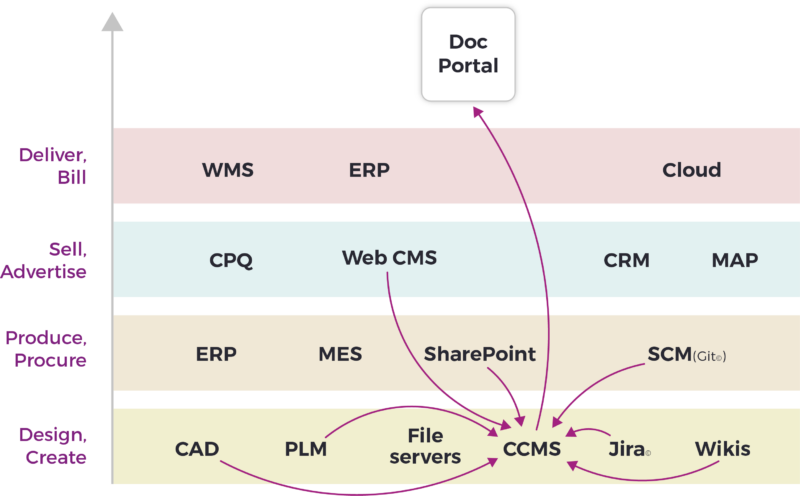
However, this method increased the burden of work on tech writers, wasting valuable time.
Another solution was for companies to design complex scripts that extracted content from each source and delivered it to the appropriate endpoints.
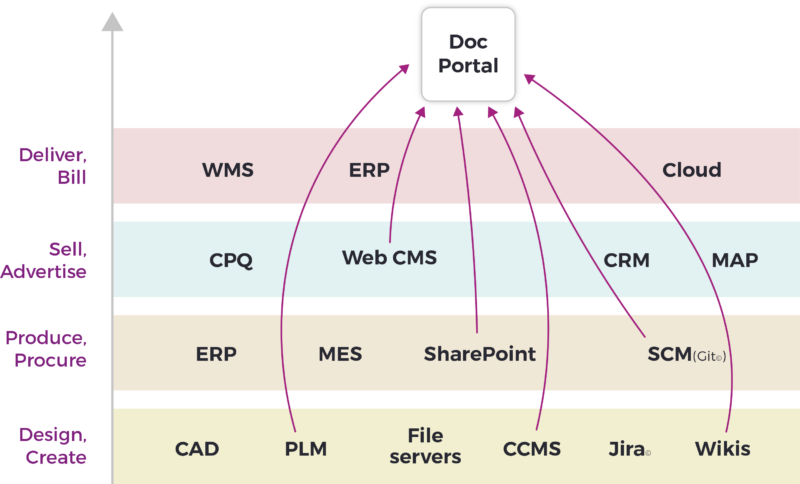
Unfortunately, this method was similarly inefficient as the scripts were complex to build and difficult to manage and maintain.
Both approaches reached their breaking points when companies faced the rapid adoption of new user-facing tools such as documentation portals, help desks, PIM solutions, LMS, Field Service Management (FSM) systems, forums, etc. Each new endpoint now requires relevant documentation in new and varied export formats, complicating operations exponentially for tech writers.
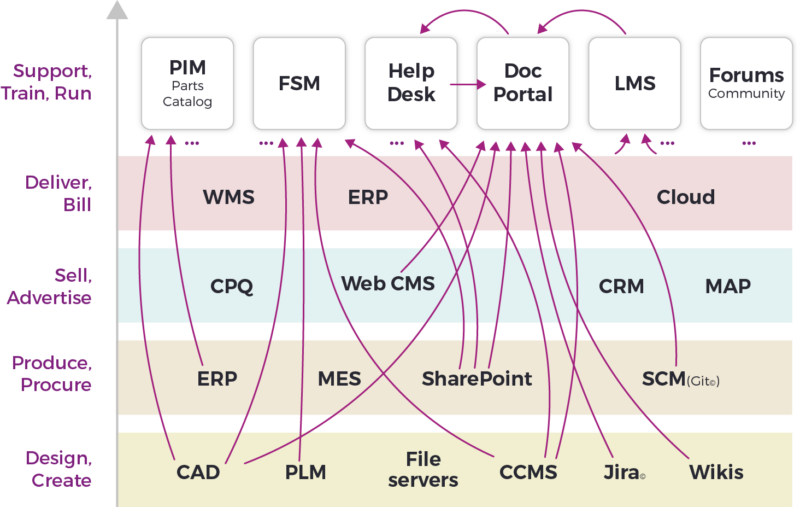
The result is a tangled web of documentation and tools that tech writers must manage on top of their at-capacity backlog of critical work. Given this context and evolving complexity, Content Delivery Platforms (CDPs), now also known as Enterprise Knowledge Platforms, have emerged to fill this gap.
Evolving from CDP to EKP
A Content Delivery Platform is more than a simple tool for extracting content from authoring tools and uploading it to endpoints. These platforms collect product knowledge in various formats from every source, then combine and harmonize it in a central knowledge repository. CDPs consolidate content before delivering it to any endpoint, be it forums, help desk tools, LMSs, websites, or AI applications like chatbots.
Enterprise Knowledge Platforms are an evolution of CDPs. EKPs harness innovative Generative AI (GenAI) technology to transform existing company content into engaging, ready-to-use user experiences by providing the building blocks needed to engineer prompts and design content interaction features. These AI capabilities — which were intrinsic, yet indirect benefits of CDPs — became defining features of EKPs. Furthermore, these Enterprise Knowledge Platforms ensure the protection of confidential information throughout the documentation management and delivery processes.
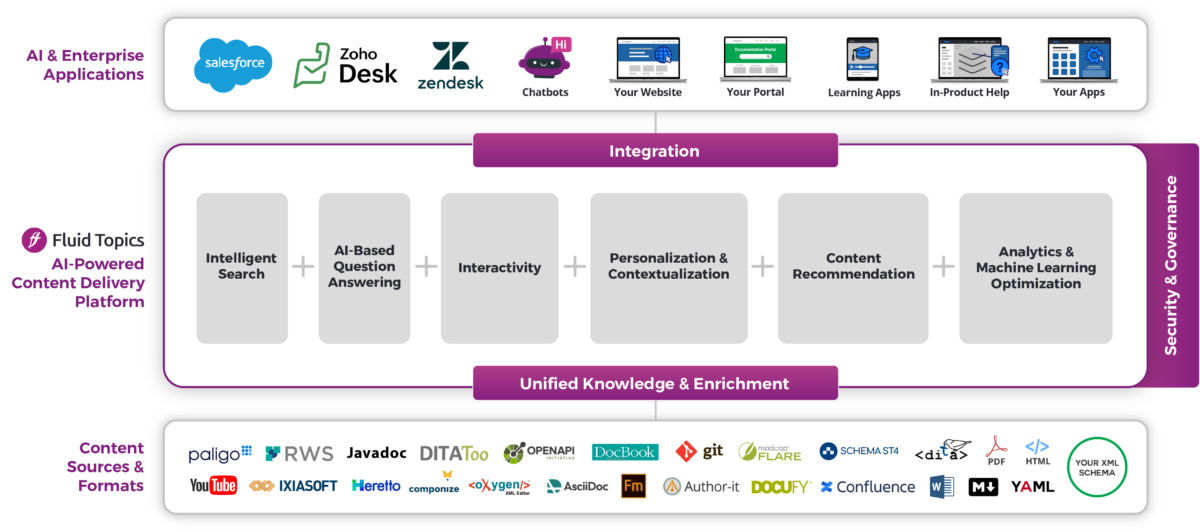
To fulfill their role in providing a seamless content experience, several key features characterize EKPs, including:
- Content centralization and unification
- Headless, API-based publishing for multichannel delivery
- Documentation portal builder
- Semantic search
- AI gateway with internal embeddings management
- Configurable Generative AI content experiences (see insert below)
- Dedicated content analytics
- Inherent content security, compliance, traceability, accessibility, and entitlements
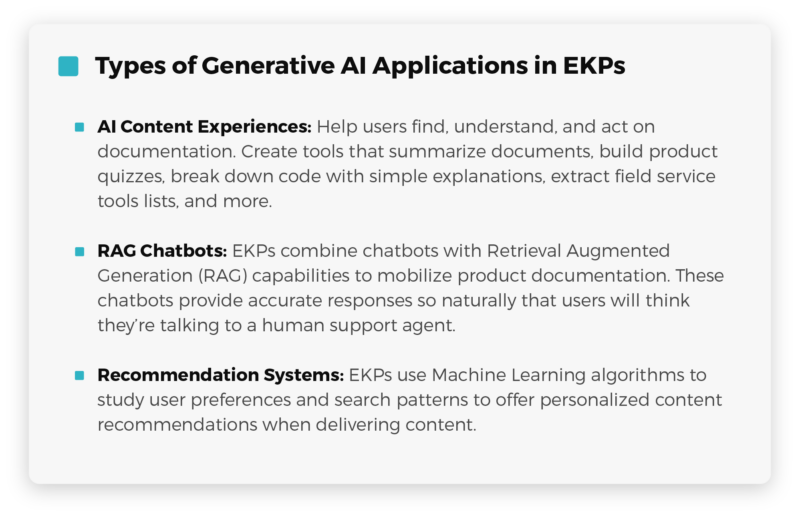
Benefits of EKPs for Technical Documentation Teams
1. Improve Publishing Efficiency
With an EKP, technical documentation teams and other content producers can write in their preferred tools without adding extra work to the backlogs of tech writers. They remove the need for technical documentation teams to adapt, rewrite, and copy content from various sources into a common tool to harmonize the format and style.
Additionally, EKPs dynamically update all endpoints when any addition or modification is made to the source content.
As a result, tech writers can focus on high-value tasks like writing and updating content.
2. Enhance Documentation Findability
If users cannot easily find specific documentation, they may think it doesn’t exist. Providing findability requires three elements:
- Centralization: Gather all content into a unified repository so it’s available for search queries.
- Indexation: Render all content in this singular knowledge base searchable from any touchpoint.
- Search Technology: Utilize a powerful search engine to find the most relevant information for each user’s needs.
Leading EKPs natively contain these three capabilities within their secure-by-design platforms, ensuring confidentiality via advanced access controls and internal embeddings computations for RAG-based AI applications. Additionally, state-of-the-art EKPs offer semantic search engines that are accessible for users from any connected tool or system. Therefore, it is easy for technical documentation teams to provide a consistently effective experience for users to acquire the information they need across endpoints.
3. Lower Dependency on IT Support
EKPs safely integrate and automate all publishing procedures. This allows tech writers to autonomously ensure their documentation is always aligned with the company’s product updates at any touchpoint without the need for external intervention. As a result, technical documentation teams are free to focus on writing, thus reducing their reliance on IT.
4. Reduce Human Error
An EKP automates the centralizing of knowledge into a unified hub. Without this, tech writers must manually publish content to each endpoint, creating a high risk of missing or out-of-date content. These human errors create inconsistent user experiences and hamper content findability. An EKP’s automated publishing relieves documentation workflows of this possibility, ensuring a seamless, consistent content experience.
5. Get a Seat at the Generative AI Table
With an EKP in place, technical documentation teams are instantly placed at the heart of Generative AI initiatives. GenAI applications are only as good as the content feeding them. Tech writers manage the consolidated content repository within an EKP and can easily connect it to RAG-enabled applications. Their role of providing access to product documentation is essential for AI applications to generate content with the level of precision and detail needed for accurate responses.
6. Optimize Tech Stack Scalability
As customer service, user expectations, and the technologies available evolve, companies will need to invest in new content endpoints. Without an EKP, each new endpoint requires extensive effort to connect it to all content sources so users can access the information they need. In short, the tangled web of documentation management becomes exponentially more complex.
Meanwhile, EKPs simplify everything. With a centralized knowledge base and dynamic delivery, adding new endpoints doesn’t require any additional efforts from tech writers. The content system becomes scalable and remains consistent.
7. Personalize Content Results
Documentation must be extensive and flexible enough to meet the needs of various audiences, each with unique backgrounds and experiences. Some users will require advanced, expert explanations while others will need simple, novice information and instructions.
EKPs use Machine Learning to understand user preferences based on their profiles and past behaviors. This allows them to select relevant search results and personalize content at the point of delivery.
8. Improve Content Tracking
Once you publish documentation, the work still isn’t over. From product releases to new use cases and general updates for clarity, content is a living entity that requires continuous improvement. EKPs provide tech writers with detailed metrics on user interactions to help them understand user needs and prioritize content updates. Key metrics to extract meaningful information include:
- Documentation contributions
- Searches with no results
- Usage metrics (Active users, time spent reading, document and topic views…)
- User interactions (Bookmarks, shared links, personal books)
- Device types
- Customer ratings and feedback
Unlock the Next Evolution of your Documentation Process with Fluid Topics
When technical documentation teams recognize the need for an Enterprise Knowledge Platform and add it into their tech stack, they tackle several problems at once. They streamline content operations, enhance documentation findability, and enable the rapid adoption of AI projects.
Fluid Topics’ AI-powered EKP mitigates common content challenges by centralizing documentation from various sources and formats to provide a comprehensive, accurate understanding of your organization’s product knowledge.
Future-proof your content strategies. Learn more about what our EKP can do for you with our on-demand demo library.
